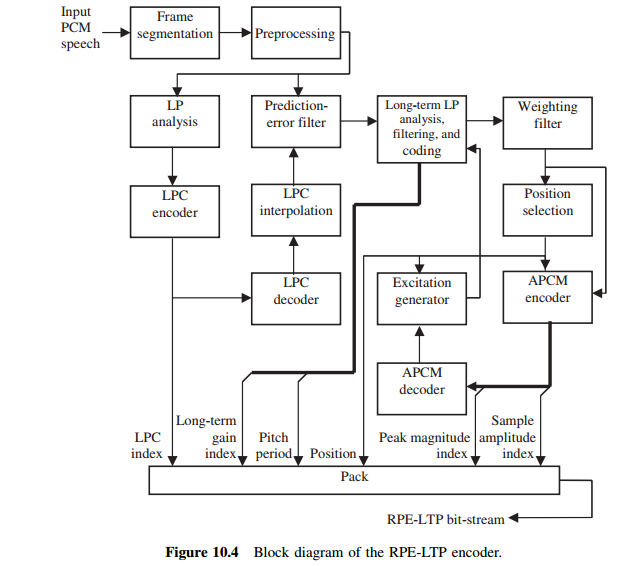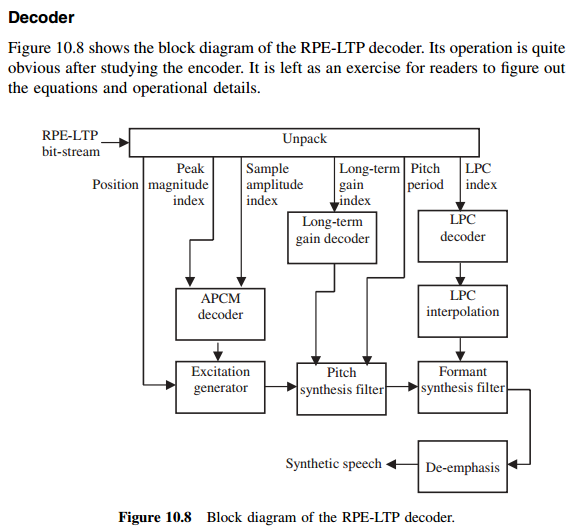
- •Вопрос 1 Structure of a Speech Coding System
- •Вопрос 3 Desirable Properties of a Speech Coder
- •Вопрос 4 About Coding Delay
- •Вопрос 5 classification of speech coders
- •Вопрос 6 Origin of Speech Signals
- •Вопрос 7 Structure of the Human Auditory System
- •Вопрос 8 Absolute Threshold
- •Вопрос 9 speech coding standards
- •Вопрос 10 pitch period estimation
- •Вопрос 11 linear prediction
- •Вопрос 12 Error Minimization
- •Вопрос 13/14 Prediction Schemes
- •0 10 20
- •Вопрос 15 long-term linear prediction
- •0 0.5 1
- •0 0.5 1
- •Вопрос 16/17 Linear Predictive Coding (lpc)
- •16. Speech encoding. Lpc encoder
- •Overview
- •Lpc coefficient representations
- •Applications
- •20 / 21 . Speech encoding. Celp coder
- •22/23. Speech encoding. Ld-celp coder
- •14.1 Strategies to achieve low delay
- •24/25 Speech encoding. Acelp (g.729) coder
- •35. Jpeg2000 in video compression(mjpeg)
- •36. Coding for high quality moving pictures(mpeg-2)
16. Speech encoding. Lpc encoder
Linear predictive coding(LPC) is a tool used mostly inaudio signal processingandspeech processingfor representing thespectral envelopeof adigitalsignalofspeechincompressedform, using the information of alinear predictivemodel.[1]It is one of the most powerful speech analysis techniques, and one of the most useful methods for encoding good quality speech at a low bit rate and provides extremely accurate estimates of speech parameters.
Overview
Main article: source-filter model of speech production
LPC starts with the assumption that a speech signal is produced by a buzzer at the end of a tube (voiced sounds), with occasional added hissing and popping sounds (sibilants and plosive sounds). Although apparently crude, this model is actually a close approximation of the reality of speech production. The glottis (the space between the vocal folds) produces the buzz, which is characterized by its intensity (loudness) and frequency (pitch). The vocal tract (the throat and mouth) forms the tube, which is characterized by its resonances, which give rise to formants, or enhanced frequency bands in the sound produced. Hisses and pops are generated by the action of the tongue, lips and throat during sibilants and plosives.
LPC analyzes the speech signal by estimating the formants, removing their effects from the speech signal, and estimating the intensity and frequency of the remaining buzz. The process of removing the formants is called inverse filtering, and the remaining signal after the subtraction of the filtered modeled signal is called the residue.
The numbers which describe the intensity and frequency of the buzz, the formants, and the residue signal, can be stored or transmitted somewhere else. LPC synthesizes the speech signal by reversing the process: use the buzz parameters and the residue to create a source signal, use the formants to create a filter (which represents the tube), and run the source through the filter, resulting in speech.
Because speech signals vary with time, this process is done on short chunks of the speech signal, which are called frames; generally 30 to 50 frames per second give intelligible speech with good compression.
Lpc coefficient representations
LPC is frequently used for transmitting spectral envelope information, and as such it has to be tolerant of transmission errors. Transmission of the filter coefficients directly (see linear prediction for definition of coefficients) is undesirable, since they are very sensitive to errors. In other words, a very small error can distort the whole spectrum, or worse, a small error might make the prediction filter unstable.
There are more advanced representations such as log area ratios (LAR), line spectral pairs (LSP) decomposition and reflection coefficients. Of these, especially LSP decomposition has gained popularity, since it ensures stability of the predictor, and spectral errors are local for small coefficient deviations.
Applications
LPC is generally used for speech analysis and resynthesis. It is used as a form of voice compression by phone companies, for example in the GSM standard. It is also used for secure wireless, where voice must be digitized, encrypted and sent over a narrow voice channel; an early example of this is the US government's Navajo I.
LPC synthesis can be used to construct vocoders where musical instruments are used as excitation signal to the time-varying filter estimated from a singer's speech. This is somewhat popular in electronic music. Paul Lansky made the well-known computer music piece notjustmoreidlechatter using linear predictive coding.[1] A 10th-order LPC was used in the popular 1980's Speak & Spell educational toy.
Waveform ROM in some digital sample-based music synthesizers made by Yamaha Corporation may be compressed using the LPC algorithm.[citation needed]
LPC predictors are used in Shorten, MPEG-4 ALS, FLAC,SILK audio codec, and other lossless audio codecs.
LPC is receiving some attention as a tool for use in the tonal analysis of violins and other stringed musical instruments.[2]
18. Speech encoding. RPE-LTP coder
10.1 MULTIPULSE EXCITATION MODEL
Consider the following speech coding method. The speech signal is segmented into
frames, with each frame LP analyzed, and the resultant LPC used to construct the
prediction-error filter, where samples of prediction error are derived. These samples
are quantized and then transmitted to the decoder together with the LPC. On the
decoder side, by filtering the quantized prediction error with the synthesis filter
constructed with the received LPC, a waveform that is closed to the original speech
is generated.
Open-Loop Method
Figure 10.1 shows the block diagram of a coding system based on the multipulse
model, with the pulses selected via an open-loop approach. The input speech is LP
analyzed to obtain the LPCs, which are used to construct the prediction-error filter.
The resultant prediction-error sequence is processed by the pulse selection block,
where a certain criterion is applied to eliminate the majority of samples. The
selected samples are encoded by their amplitudes and positions. The decoder
recovers the information, regenerates the excitation sequence, and passes it through
the synthesis filter to obtain the synthetic speech.
Many criteria can be used in the pulse selection block. A simple scheme can
be based on the magnitude of the pulses, where the samples are first sorted


